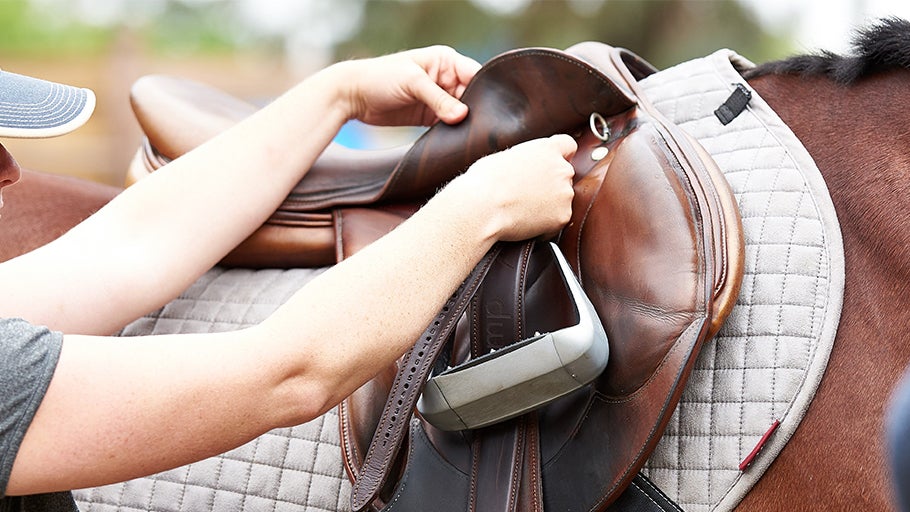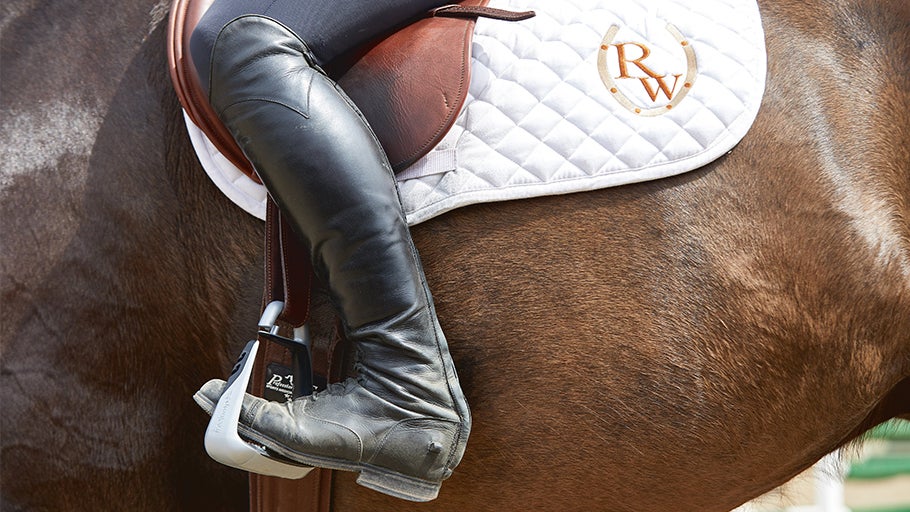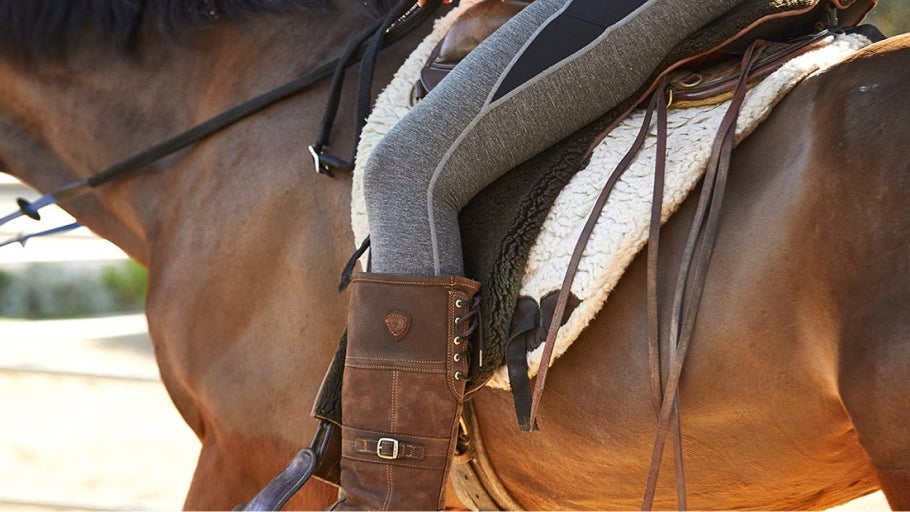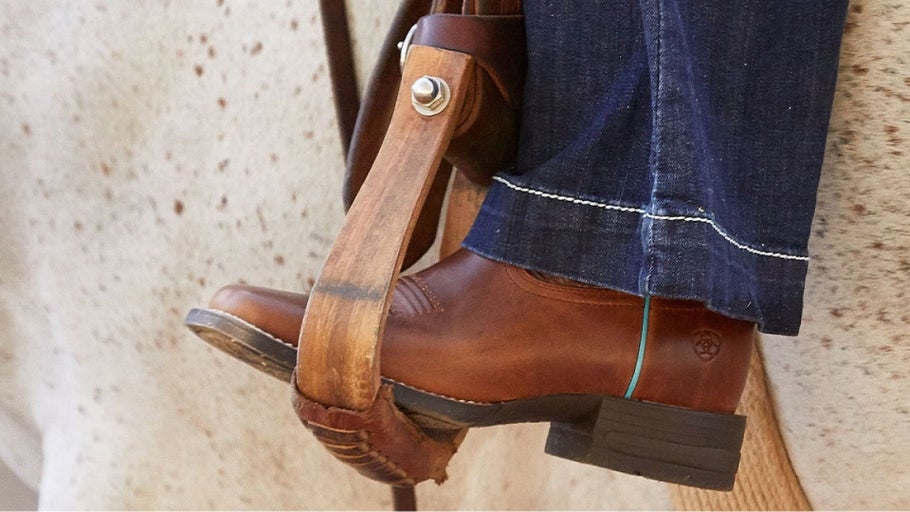
How to Choose Horseback Riding Stirrups
Choosing the right horseback riding stirrups might seem like a small detail, but it can make a world of difference in your overall riding experience. Whether you're a seasoned competitive rider or just starting, finding the perfect pair of stirrups is key to your comfort, safety, and performance in the saddle. In this guide, we will break down everything you need to know about stirrups, from the different styles and materials to what makes a stirrup the right fit for you.
Whether you ride English, Western, or Endurance, our crew of equine experts is experienced with horseback stirrups that cater to different riding disciplines. We're here to help you navigate the world of stirrups by answering commonly asked questions about a variety of stirrup features. Let's jump right in and find your ideal stirrups together!
What are Horseback Riding Stirrups?
Horseback riding stirrups are the sturdy supports that hang down from your saddle where you place your feet. They help you maintain balance and stability in the saddle, allowing you to control your horse more effectively. Stirrups also make mounting and dismounting easier and give you a secure place to rest your feet while riding long distances.
Different stirrups can offer various benefits. Some are designed to reduce leg fatigue, providing extra comfort for long rides. Others have features like a wide tread or shock-absorbing materials that help you stay secure and feel less concussion over jumps or rough terrain. There are also specialized stirrups with advanced safety features like a quick-release mechanism in case of an emergency. Continue reading to understand the key factors that you will want to keep in mind when choosing the right stirrups for you.
Key Factors to Choosing Riding Stirrups
Before diving into the vast array of stirrups, it is important to assess your specific needs and preferences. Essential factors to consider that will help streamline the process are:
Riding Discipline
You will want to choose a stirrup tailored to the specific performance and safety demands of your discipline, as well as the saddle you ride in.
Size Needed
The inner width of your stirrups is crucial for safety during your ride, and your footbed depth will be chosen based on preference and discipline. For western-style and endurance-style stirrups, you will need the proper width of the top bar (neck) to match your fenders.
Weight & Material Preference
Choosing the right weight and material ensures that your stirrups match the demands of your riding style, maximizing comfort and performance.
Special Features
There are varying stirrups for each discipline that use special features to help boost a rider's performance in the saddle and even aid in reducing pain and fatigue after injuries.
Stirrups for the Riding Disciplines
Your riding discipline is the most essential factor to consider when choosing stirrups, because different disciplines place unique demands on both the rider and tack equipment. Each discipline has specific requirements that influence the design and function of the stirrups. Each discipline will also use a different saddle, which can affect what types of stirrups you can choose from.
English Riding Stirrups
Designed with both form and function in mind, English riding stirrups are a key component of the English rider's tack. Typically made from stainless steel, aluminum, or composite materials, these stirrups are sleek in design to complement the refined look of English tack and commonly have a polished finish.
The structure is circular in design with thin bars, a rectangular footrest, and a narrow slot at the top to attach to the saddle via a slim stirrup leather. This allows the rider's foot to rest securely in the stirrup while maintaining close contact with the horse. For more information, check out our guides on the ins and outs of choosing stirrups leathers and adjusting your stirrups!
The footbed of English stirrups is generally more narrow compared to western stirrups and often features a non-slip tread to enhance grip. English stirrups assist riders in maintaining proper position, helping them to stay balanced in the saddle. This balance is essential for various English disciplines like dressage and jumping, where precise leg aids are necessary.
Endurance Riding Stirrups
Endurance riding stirrups are designed with the unique demands of long-distance riding in mind. They typically have a wider tread to provide a larger surface area for the rider's foot. This wider base helps distribute the rider's weight more evenly, reducing pressure points and alleviating foot and ankle fatigue during hours of continuous riding.
The overall design of endurance stirrups tends to be lightweight yet durable, often made from materials like aluminum or high-strength plastic. The lightweight construction reduces the overall load on the horse, which is especially important in endurance riding where every ounce of weight counts over long distances.
Endurance stirrups can have special features like cages, quick-release designs, or angled footbeds. These stirrups are essential for riders covering extensive distances, as they offer comfort, safety, and support to help the rider maintain an effective riding position and reduce fatigue throughout their ride.
Western Riding Stirrups
Western riding stirrups are designed to provide riders with stability, comfort, and safety, especially during long hours in the saddle that are common at the ranch. Unlike English stirrups, western stirrups are typically broader, offering a larger and wider platform for your foot. This helps accommodate the traditional cowboy boot that is worn in western riding.
Many western stirrups are crafted from durable materials like wood, metal, or reinforced plastic, and they're often covered in leather. This construction ensures they can withstand the demands of ranch work, rodeo events, and other western riding activities that require durability.
In addition to their practical features, western stirrups often showcase intricate designs or craftsmanship that reflect the cultural heritage of the west. These decorative elements can include engraved metal, tooled leather, or leather tassels, making them functional but also a statement of personal style.
Riding Stirrup Sizing
Safety should be a top priority when selecting stirrups, and size plays a critical role in keeping you secure in the saddle. There are two main parts of sizing that you will want to pay attention to: the inside/footbed width, and the footbed depth. Some western-style and endurance-style stirrups also have a neck width (AKA top bar width) that is important when finding the correctly sized stirrup for your saddle.
Inside/Footbed Width
For sizing purposes, a good rule of thumb is to have the inside width of the stirrup footbed one inch wider than your boots (1/2 inch on each side).
Stirrups with a footbed that is too narrow can trap your foot, increasing the risk of getting stuck in the event of a fall. On the other hand, stirrups that are too large can cause your foot to slip, leading to instability. The right size allows for just enough space to ensure a quick release if necessary, while maintaining proper foot placement.
You will want to keep in mind that English stirrups are made for a boot that has a slim profile. Western-style and most endurance-style stirrups will accommodate a wider boot.
Footbed Depth
Footbed depth is an important part of choosing the correct stirrups for your riding discipline, though it is partially up to personal preference.
In speed and precision events like barrel racing, reining, and cutting, a narrow depth is usually preferred for precise foot placement and the ability to grip the stirrups tightly at high speeds and quick turns.
Generally, a wider footbed depth is common for riders spending long hours in the saddle or traveling long distances. The wide base reduces fatigue by giving you a larger area to rest your foot. Common with endurance riders, trail riders, and those working long hours on the ranch, a wide base also gives a more supported, stable feel for those who need more confidence in the saddle.
Neck/Top Bar Width
Another important part of stirrup sizing for all western and endurance riders is the neck width, or top bar, of your stirrups (the width of the top of the stirrup that attaches to your saddle). You will want to measure the width of your leathers and select your neck width accordingly. If your fender or stirrup leather measurement falls in between sizes, choose the larger of the two neck widths.
Riding Stirrup Weights & Materials
When it comes to choosing stirrups, the weight and material can significantly impact your ride, affecting both comfort and performance. Ultimately, the best stirrup weight and material come down to your riding discipline and personal preference.
Stirrup Weight
The weight of your stirrups is an often overlooked part of choosing the right pair for you. A lighter stirrup allows for quicker reactions and cues, common in disciplines like barrel racing, but may be harder to retrieve if you lose a stirrup in disciplines like jumping. They help reduce fatigue during long rides and are generally preferred by endurance riders.
Some riders prefer heavier stirrups because they offer increased stability and give the rider an anchoring place for a more secure feel. Generally, heavy stirrups can also make it easier to find a stirrup if the rider loses it mid-ride, as the weight tends to keep them down by the horse's side and prevent swinging. For some, this added weight improves their confidence and balance in the saddle, and it can be beneficial when a horse is green or unpredictable, so heavier stirrups are commonly used by colt starters. They are also favored by riders who need added stability over rough terrain during shorter trail rides.
Stirrup Materials
Here is a breakdown of common materials used in horseback riding stirrups. Each material offers unique advantages and disadvantages and should be chosen by balancing what weight, durability, and comfort may work for you and your riding discipline.
Stainless Steel
- Pros: Durable, corrosion-resistant, classic look, and heavier weight. Long-lasting and maintain their shape.
- Cons: Heaviness can cause fatigue, not naturally flexible or shock absorbing.
Aluminium
- Pros: Light weight minimizes fatigue, resistant to water and mud.
- Cons: Can feel less stable than heavier materials and can be prone to dents or scratches.
Plastic or Composite
- Pros: Ultra-lightweight, many feature added tread for extra grip.
- Cons: Some riders may find them too light.
Wood
Pros: Traditional look and natural shock absorption.
Cons: Does not handle moisture well.
Riding Stirrups with Special Features
Thanks to modern innovations, stirrups now offer you more than just a place to rest your feet; they can enhance comfort, safety, and performance with special features to suit the extra needs of some riders. Whether you are a recreational endurance rider, a professional show jumper, or you make a living roping cattle, stirrups with advanced features can elevate your ride in ways you might not expect.
Shock Absorption
For riders who spend long hours in the saddle, ride disciplines with repeated concussion, or even riders who suffer from joint issues, shock-absorbing stirrups can make a world of difference. Designed to cushion the impact between rider and horse, these stirrups are ideal for disciplines that include jumping, endurance, and trail riding. The built-in shock-absorption technology reduces pressure on your knees, ankles, and even your back, helping to prevent soreness.
Safety Stirrups
Safety is always a top priority that can give you that extra boost of confidence to perform at your best. Safety stirrups are usually designed with a latch that opens under pressure to release your foot in case of a fall. Great for any discipline, safety stirrups are common for jumping, cross country, and trail riding where accidents can happen unexpectedly.
Grip Enhancements
Some stirrups come designed with advanced grip technology, including rubber or textured footplates to help your foot stay in place and give you extra security. Rain or mud can make traditional stirrups slippery, but stirrups with enhanced grip give you the traction you need no matter the weather conditions or terrain.
Angled Stirrups
Angled stirrups are a smart choice for riders of any discipline seeking to relieve joint pain or numbness in the toes, or who just want some assistance with sinking into their heels. Angled stirrups can be found in the english, western, and endurance disciplines. English stirrups tend to have an angled footbed to help maintain proper position and keep your heels down. Western and endurance stirrups are usually made with an angled neck to allow the leg to fall into a more natural position, helping to relieve knee, ankle, and back pain.
Frequently Asked Questions
Are riding stirrups made in children's sizes?
Yes, some stirrups are sized for children and petite adults. Having an accurately sized stirrup can make a big difference in comfort while riding. The Centaur Fillis Peacock Stirrups are the "old reliable" of the equestrian world. They have a wide size range and a friendly price point, making them the perfect starter or childrens stirrup!
Are certain English stirrups better for different disciplines?
Are there certain Western stirrups that are best for barrel racing?
Can English and Western stirrups be used for endurance?
Closing Thoughts
At Riding Warehouse, we believe the right stirrups can truly transform your ride. Whether you are conquering rugged trails, fine-tuning your dressage movements, or running barrels, the right stirrups keep you safe, comfortable, and riding at your best. With a wide range of options, from timeless classics to cutting-edge designs, we carry something to suit every rider's unique needs. At Riding Warehouse, we are here to support you with quality products and expert advice. If you have any questions or need further guidance, please reach out to our customer service associates via phone at 1-800-620-9145 or email info@ridingwarehouse.com for assistance. In the meantime, happy riding!
Related Articles












